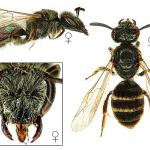Clearly one of the Lasioglossum calceatum group of bees, although it is fairly large for the genus, with males and females about 8 mm long. Females have mid-brown abdomens with paler apices to the segments; the males are similar, but also have red-brown markings on the anterior tergites of the abdomen. The species may abound within its very restricted range, creating very large nesting aggregations.
Very restricted in Britain, being found only on the unstable sea cliffs of South Devon and Dorset. It is widely distributed throughout southern and central Europe.
This bee is listed as being RDB2 (Vulnerable) in both Shirt (1987) and Falk (1991).
South-facing unstable clay and sand sea-cliffs with associated flower-rich grasslands. The clays are clearly winter-wet and large segments get washed away in winter storms.
Females may be found between April and September, males between July and September. As with all Lasioglossum, only mated females hibernate.
A eusocial species which makes a small brood chamber within damp clay. Nest sites are often within actively slumping areas of clay. It uses desiccation cracks to gain entrance to the damper clay under the hard surface crust.
Recorded visiting a wide variety of flowers from a number of different plant families.
No records from Britain, although observations suggest that the cleptoparasitic bees Sphecodes ephippius (Packer 1983) and S. monilicornis (G R Else, pers. comm.) may utilise this species.
2005


